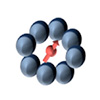| Sep 24, 2024 |
|
(Nanowerk News) Battery performance is heavily influenced by the non-uniformity and failure of individual electrode particles. Understanding the reaction mechanisms and failure modes at nanoscale level is key to advancing battery technologies and extending their lifespan. However, capturing real-time electrochemical evolution at this scale remains challenging due to the limitations of existing sensing methods, which lack the necessary spatial resolution and sensitivity.
|
|
Now, researchers from SUO Liumin’s team and LIU Gangqin’s team from Institute of Physics of the Chinese Academy of Science have developed a quantum sensing approach based on diamond nitrogen-vacancy (NV) centers.
|
|
They reported their findings in Device (“Operando quantum sensing captures the nanoscale electrochemical evolution in batteries”).
|
 |
| Schematic of the operando quantum sensing for the battery. (Image: Institute of Physics, CAS)
|
|
NV sensors offer spatial resolution from 1nm to 1μm and are sensitive to variations in temperature, stress, and magnetic fields, holding great potential for real-time, non-destructive monitoring of battery electrode particles.
|
|
Using an integrated device combining quantum sensing system with battery, researchers achieved in-situ monitoring of nanoscale active material particles, demonstrated by Fe3O4 electrodes.
|
|
Their findings revealed non-uniform phase transformations from Fe3O4 to FeO and then to Fe during discharge, with significant microscopic kinetic differences across regions.
|
|
The study also uncovered superparamagnetic behavior in Fe particles.
|
|
The significant difference in magnetic field and temperature distribution within the electrode are also revealed through multithreaded sensing in this study.
|
|
These results demonstrated the potential of diamond NV centers for wide-area, high-resolution characterization of nanoscale region within electrode, offering new insights into material behavior and failure mechanisms.
|


